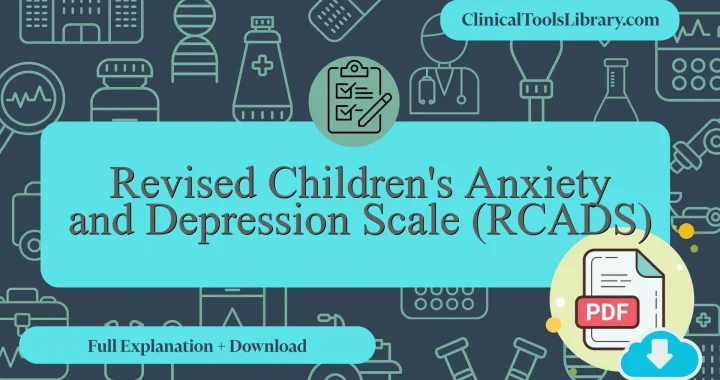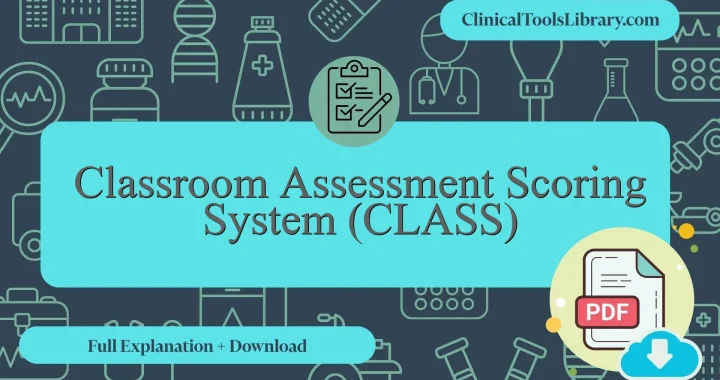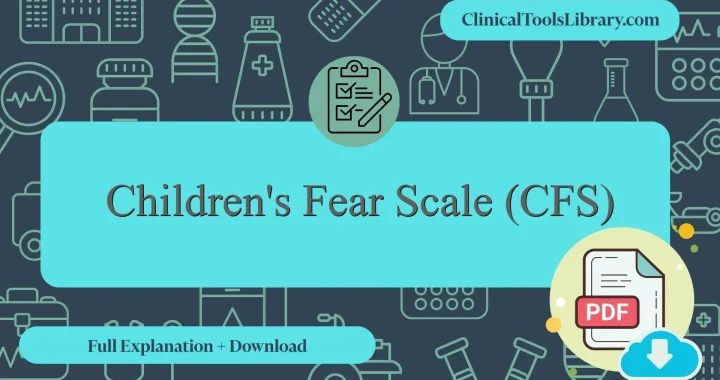In this article, we explain everything you need to know about the Revised Children’s Anxiety and Depression Scale (RCADS). We will cover the aspects it evaluates, the target population, a detailed step-by-step explanation, and how to interpret its results. Additionally, we will dive into the scientific evidence supporting this tool (diagnostic sensitivity and specificity) in clinical assessment. You will also find official and unofficial sources available for download in PDF format.
What does the Revised Children’s Anxiety and Depression Scale (RCADS) assess?
The Revised Children’s Anxiety and Depression Scale (RCADS) is a standardized self-report questionnaire designed to assess the presence and severity of anxiety disorders and depressive symptoms in children and adolescents. Its primary purpose is to facilitate early identification and quantification of symptoms related to generalized anxiety disorder, social phobia, panic disorder, separation anxiety disorder, obsessive-compulsive disorder, and major depressive disorder. The RCADS-47 and its abbreviated version, RCADS-25, provide reliable scoring metrics which are interpreted using tools such as the RCADS scoring sheet and rcads t-score calculator. The use of the Child FIRST lab RCADS Conversion table aids in converting raw scores into meaningful clinical data. Clinicians often utilize the RCADS scoring interpretation guidelines to inform diagnostic decisions and treatment planning, ensuring evidence-based assessment aligned with current psychiatric standards.
For which type of patients or populations is the Revised Children’s Anxiety and Depression Scale (RCADS) intended?
The Revised Children’s Anxiety and Depression Scale (RCADS) is indicated primarily for children and adolescents aged 8 to 18 years who present with symptoms of anxiety disorders and depressive disorders. It is most useful in clinical contexts that require the assessment and monitoring of internalizing symptoms across various diagnostic categories, including generalized anxiety disorder, social phobia, separation anxiety disorder, panic disorder, obsessive-compulsive disorder, and major depressive disorder. The tool facilitates differential diagnosis and treatment planning by providing reliable quantification of symptom severity through standardized scoring methods, which can be interpreted using available resources such as the RCADS scoring interpretation guides and the rcads t-score calculator. Utilization of the RCADS scoring sheet alongside normative data ensures accurate evaluation in both outpatient and inpatient pediatric mental health settings, supporting evidence-based clinical decision-making.
Step-by-Step Explanation of the Revised Children’s Anxiety and Depression Scale (RCADS)
The Revised Children’s Anxiety and Depression Scale (RCADS) consists of 47 items designed to assess symptoms related to anxiety and depression in children and adolescents. Each item presents a statement reflecting symptoms of various disorders, including generalized anxiety disorder, social phobia, panic disorder, and major depressive disorder. Respondents are asked to rate how often each statement applies to them using a four-point Likert scale: 0 (Never), 1 (Sometimes), 2 (Often), and 3 (Always). The administration process begins with clear instructions provided to ensure accurate self-reporting. After completion, item scores are summed to generate subscale scores for specific disorders, which can then be interpreted using standardized normative data. This standardized approach facilitates the reliable identification of internalizing disorders within pediatric populations.
Downloadable RCADS PDF Resources: Scoring Sheets and Conversion Tables for Clinicians
Below, users will find downloadable resources in both the original and English versions of the Revised Children’s Anxiety and Depression Scale PDF. These materials include essential tools such as the RCADS scoring sheet and the Child FIRST lab RCADS Conversion table, designed to facilitate accurate assessment and interpretation of anxiety and depression symptoms in pediatric populations. The provided documents support clinicians and researchers in implementing standardized evaluations in a professional and efficient manner.
How to interpret the results of the Revised Children’s Anxiety and Depression Scale (RCADS)?
The Revised Children’s Anxiety and Depression Scale (RCADS) provides quantifiable scores across multiple subscales, including Generalized Anxiety Disorder, Separation Anxiety, and Major Depressive Disorder. Scores are converted into T-scores, where values above 65 typically indicate clinically significant symptoms warranting further evaluation. Specifically, T-scores between 60 and 65 are considered borderline, suggesting elevated risk, while scores below 60 are within normative ranges for age and gender. The calculation follows the formula T = 50 + 10 × ((Raw Score – Mean)/Standard Deviation), enabling standardized interpretation across populations. Practically, healthcare professionals use these thresholds to guide diagnostic considerations and treatment planning, identifying children who may benefit from targeted interventions or referral to specialized mental health services.
What scientific evidence supports the Revised Children’s Anxiety and Depression Scale (RCADS) ?
The Revised Children’s Anxiety and Depression Scale (RCADS) is a well-validated instrument developed in the early 2000s by Chorpita, Yim, Moffitt, Umemoto, and Francis to assess symptoms associated with anxiety disorders and major depressive disorder in youth. Its validation process involved large clinical and community samples, demonstrating strong internal consistency (Cronbach’s alpha ranging from 0.78 to 0.92) and robust construct validity across diverse populations. Factor analyses consistently supported the measure’s six-factor structure corresponding to generalized anxiety disorder, social phobia, separation anxiety disorder, panic disorder, obsessive-compulsive disorder, and major depressive disorder. Longitudinal studies have further corroborated its predictive validity for treatment outcomes and diagnostic accuracy compared with structured clinical interviews. Cross-cultural adaptations and translations have upheld its psychometric properties, confirming the RCADS as a reliable and empirically supported tool in pediatric mental health assessment.
Diagnostic Accuracy: Sensitivity and Specificity of the Revised Children’s Anxiety and Depression Scale (RCADS)
The Revised Children’s Anxiety and Depression Scale (RCADS) has demonstrated sensitivity values ranging from approximately 78% to 89% for detecting anxiety disorders and depressive symptoms in pediatric populations. Specificity estimates typically fall between 75% and 85%, indicating a relatively high ability to correctly identify individuals without these disorders. These metrics can vary depending on the cutoff scores used and the population characteristics, but overall, the RCADS provides reliable screening performance in clinical and research settings for early identification of internalizing psychopathology among children and adolescents.
Related Scales or Questionnaires
Several scales share similarities with the Revised Children’s Anxiety and Depression Scale (RCADS), including the Screen for Child Anxiety Related Emotional Disorders (SCARED), the Multidimensional Anxiety Scale for Children (MASC), and the Children’s Depression Inventory (CDI). Like the RCADS, these instruments assess pediatric anxiety and depression symptoms, but each varies in scope and specificity. For example, SCARED offers robust subscale differentiation for various anxiety disorders, whereas MASC provides a broader profile of anxiety manifestations but is lengthier and may require more time for administration. The CDI focuses specifically on depressive symptoms, offering less comprehensive anxiety assessment compared to RCADS. These scales or questionnaires, including detailed RCADS scoring interpretation and the RCADS t-score calculator, are already explained and available for download on ClinicalToolsLibrary.com. Advantages of the RCADS include its dual assessment of anxiety and depression with well-validated cutoffs, particularly evident in versions such as RCADS-25 and RCADS-47, which provide flexibility based on clinical need. However, its limitations include reliance on self-reporting and potential underdetection of comorbid or externalizing disorders, which may necessitate complementary tools like the Child FIRST lab RCADS Conversion table and RCADS scoring sheet to enhance clinical utility.




